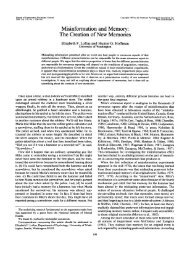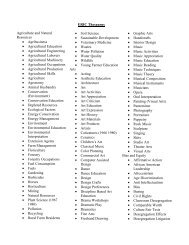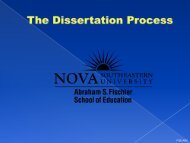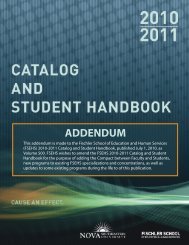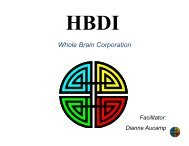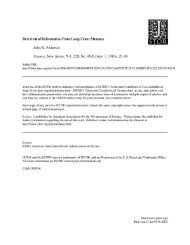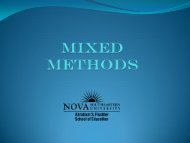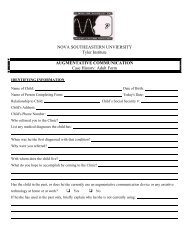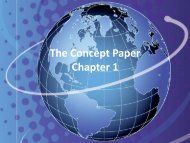Applied Research Workshop Writing Chapter 5: Discussion - 1
Applied Research Workshop Writing Chapter 5: Discussion - 1
Applied Research Workshop Writing Chapter 5: Discussion - 1
- No tags were found...
Create successful ePaper yourself
Turn your PDF publications into a flip-book with our unique Google optimized e-Paper software.
<strong>Writing</strong> <strong>Chapter</strong> 5: <strong>Discussion</strong>
Overview of <strong>Chapter</strong> 5• A well-written <strong>Chapter</strong> 5 should includeinformation about the following:– Summary of findings– Interpretation of findings– Context of findings– Implications of findings– <strong>Discussion</strong> on limitations of study– <strong>Discussion</strong> on future directions of research/field
Summary of Findings• Begin with a summary of your results using littleor no statistical jargon.• Use “the layperson test”: How would you explainyour findings to a relative?• One way to organize this section is aroundwhether findings did or did not support thestudy’s hypotheses or research questions.• Make sure to include unusual findings as well(e.g., results that you did not expect to besignificant but were, and vice versa).
Interpretation of Findings• This section addresses the meaning of your findings.• In some cases, when your results are in the directionyou predicted, this meaning was anticipated when thestudy was designed.• In cases where the results are not all in the desireddirection, researchers must explain why this was notthe case.– Address sampling, measurement, and procedural issues aswell as confounding variables• Keep in mind that the absence of significant findingsdoes not necessarily mean the confirmation of the nullhypothesis; explore alternative explanations.
Context of Findings• Remember that your study, as important as it is,was not the only one in the area, and, as such, itmust fit the existing literature.– Consider how the findings fit the Literature Review interms of population characteristics, assessmentinstruments, independent variables, research design,and procedures.– Are your findings in agreement with existingliterature? Do they contradict it? Do the findingsextend previous research? Do they solve or clarifycontradictions in the literature?
Implications of Findings• This section addresses the issue of whether researchfindings improve (or change) the field’s understandingof the phenomenon under investigation.• Consider the implication of findings in at least threeareas: theory, research, and practice.– Are findings consistent with current theories in the field?Are they consistent with selected theoretical framework?– Does the study help advance research methodology? (e.g.,understanding of new confounding variables, issues ofmeasurement, issues of design)– Who may be interested in using these findings in aprofessional field? Why should they pay attention to thefindings? Could the findings lead to changes in the wayprofessionals “do” things?
Limitations• Think of it as a “humility subsection.”• In your proposal, you would have addressedpotential limitations of the study as the finalsubsection of <strong>Chapter</strong> 3.• Look at potential limitations as you initiallyproposed and then discuss those that mayhave affected—one way or another—yourfindings.
Limitations (cont.)• Limitations typically originate in one of twosources: the study’s design and the study’sproblems during implementation.• Issues of design involve decisions aboutsampling, assessment, procedures, and choiceof research design (poor match).• Issues of implementation must be addressed(e.g., low sample, measurement issues,heterogeneous groups).
Limitations (cont.)• Think of limitations in four major areas (but allfour need to be present):– Internal Validity: unless the study is a “trueexperiment” one cannot claim that the IV “caused”changes in the DV– External Validity: issues of the extent to which findingscan be generalized must be discussed– Measurement: discuss issues of reliability and validityof assessment instruments– Statistical analysis: discuss issues of power, effect size,conservative or liberal statistics and statistical testchosen
Future Directions• Discuss findings in light of questions or issuesthat suggest future research directions.• Extend the study to other populations.• Think of other IVs and DVs that ought to beexplored in the field, also, think of how to assessthose additional variables.• This is the section of the paper where mostresearchers are allowed to dream; think ofextending your study to other questions that mayadd to the understanding of the issues.
Tips to Write <strong>Chapter</strong> 5• Be a critical thinker; as you write your concludingremarks, play the devil’s advocate and put yourself inthe shoes of your future readers.• Avoid common mistakes:– If the numbers seem to suggest a direction but are notstatistically significant, then don’t treat them as if theywere significant– Do not use cause-effect language to refer to correlations– Do not think of statistical significance as effect size– Do not present new analyses in the discussion section– Do not make <strong>Chapter</strong> 5 a repetition of <strong>Chapter</strong> 4
ARC Guidelines• Templates may be found in the <strong>Applied</strong>Dissertation Procedures Manual and at theARC website.• <strong>Chapter</strong> 5 is only submitted as part of the finaldissertation report (i.e., not in the proposal)• Additional headings, based on the student’stopic, may be included.
ARC Guidelines (cont.)• Introductory paragraphs provide an overview ofthe study• Results are elaborated and interpreted insequence and relative to each research question• Conclusions and summaries regarding thefindings are offered• Findings are linked to existing research• Implications of findings are discussed• Limitations are indicated• Recommendations for future research are offered
<strong>Chapter</strong> 5 Outline• Summary of Findings– Avoid technical detail– Use clear language• Interpretation of Findings• Context of Findings– Consider if there is convergent or divergent findings ascompared to existing literature• Implications of Findings– Theoretical implications– Methodological implications– <strong>Applied</strong> implications
<strong>Chapter</strong> 5 Outline (cont.)• Limitations of Study– Internal and external validity issues– Measurement and statistical issues• Future Directions• Remember:– Be a critical thinker– Avoid common problems– Use an outline to write the chapter
ReferenceCone, J. D., & Foster, S. F. (2006). Dissertationsand theses from start to finish: Psychologyand related fields. Washington, DC:American Psychological Association.




